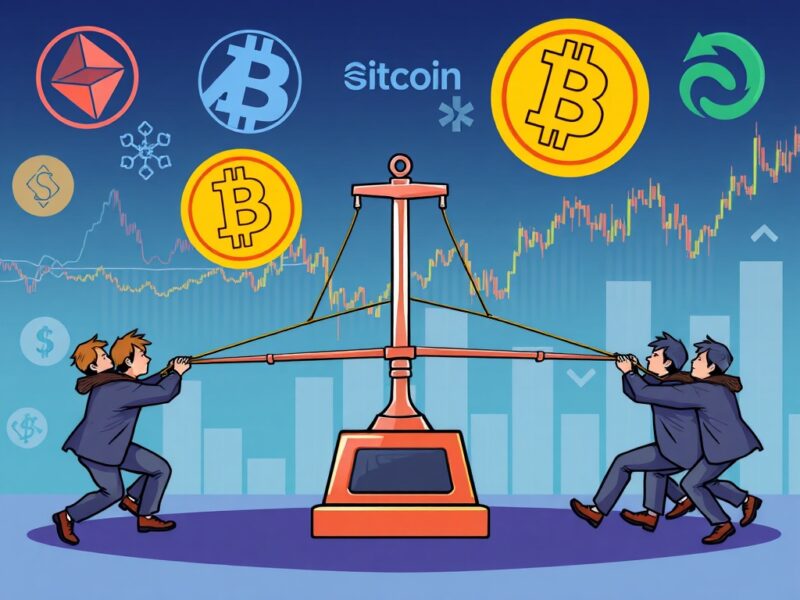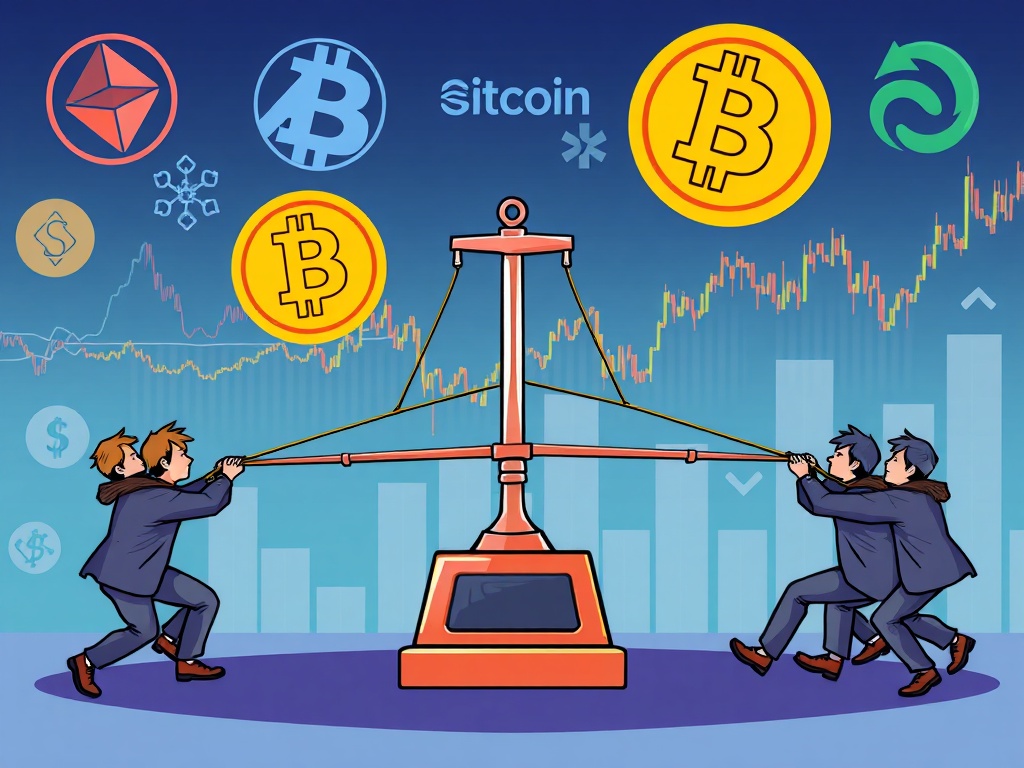BTC Perpetual Futures: Unveiling the Market’s Current Stance
0
0

BitcoinWorld

BTC Perpetual Futures: Unveiling the Market’s Current Stance
Ever wondered about the hidden battles shaping Bitcoin’s immediate price action? The world of BTC perpetual futures offers a fascinating glimpse into trader sentiment, and one of the most telling indicators is the long/short ratio. This metric helps us understand whether the majority of traders are betting on Bitcoin’s price to rise or fall.
Decoding the BTC Perpetual Futures Pulse
At its core, a BTC perpetual future is a type of derivative contract that allows traders to speculate on the future price of Bitcoin without actually owning the underlying asset. Unlike traditional futures, perpetual futures don’t have an expiry date, making them popular for continuous trading.
Over the past 24 hours, the aggregate long/short position ratio for BTC perpetual futures on the world’s top three crypto futures exchanges by open interest revealed a delicate balance. We observed a ratio of 50.2% long positions to 49.8% short positions. This indicates a slight lean towards bullish sentiment, yet it also suggests a market that is remarkably evenly split.
A Closer Look: Exchange-Specific BTC Perpetual Futures Sentiment
While the aggregate number provides a general overview, breaking down the data by individual exchange offers a more nuanced perspective. Each platform attracts a slightly different trader demographic, which can influence their respective ratios.
- Binance: On this leading exchange, the sentiment was slightly more bullish, with 50.56% long positions against 49.44% short. This indicates a marginally stronger belief in price appreciation among Binance traders.
- Bybit: Bybit traders showed a very similar balance to the overall market, reporting 50.13% long and 49.87% short. This near-even split reflects a cautious equilibrium.
- Gate.io: Interestingly, Gate.io stood out with a slightly bearish tilt. Here, we saw 49.07% long positions versus 50.93% short. This suggests a segment of traders anticipating a potential downward movement.
These variations are crucial because they highlight that market sentiment isn’t monolithic. Different trading communities can hold differing views, even on the same asset. Therefore, a comprehensive analysis requires looking beyond just the headline numbers.
What Do These BTC Perpetual Futures Ratios Truly Mean for Traders?
The long/short ratio is more than just a statistic; it’s a window into collective trader psychology. When the ratio heavily favors longs, it can signal over-optimism, potentially setting the stage for a correction. Conversely, an extreme short bias might suggest capitulation, often preceding a bounce.
For traders, understanding this ratio offers several benefits:
- Gauging Market Sentiment: It provides a quick snapshot of whether the crowd is generally bullish or bearish.
- Identifying Potential Reversals: Extreme ratios can sometimes act as contrarian indicators.
- Informing Strategy: It helps in deciding whether to follow the trend or prepare for a potential shift.
However, there are also challenges. The long/short ratio is not a standalone indicator. It can be influenced by large players, and sudden shifts can occur. It’s essential to use it in conjunction with other tools.
An actionable insight for traders is to compare the long/short ratio with other metrics like funding rates and open interest. High funding rates alongside a skewed long/short ratio, for instance, could indicate an overheated market ripe for a pullback. Always consider the broader market context.
Navigating the Dynamics of BTC Perpetual Futures Trading
Trading BTC perpetual futures comes with inherent risks, primarily due to the use of leverage. While leverage can amplify gains, it can also magnify losses, making risk management paramount. Traders should always define their stop-loss levels and understand their liquidation prices.
The current near-even split in the BTC perpetual futures long/short ratio suggests a market without strong directional conviction at this moment. This kind of balanced sentiment can often lead to consolidation periods or increased volatility as both sides vie for dominance. Therefore, adaptability and careful position sizing are key.
For example, if you notice the aggregate ratio starting to heavily favor longs after a significant price pump, it might be a signal to tighten stop-losses or consider taking some profits, as the market could be getting overextended. Conversely, a strong shift towards shorts during a dip could indicate an opportune moment for a contrarian long position, assuming other indicators align.
The Delicate Balance of Bitcoin’s Future
The latest data on BTC perpetual futures long/short ratios paints a picture of a market in equilibrium, albeit with minor fluctuations across different exchanges. This balance underscores the ongoing debate among traders regarding Bitcoin’s immediate trajectory. While a slight bullish lean is present, the absence of an overwhelming bias suggests caution and a lack of strong conviction from either side.
For anyone involved in the crypto markets, keeping an eye on these ratios is vital. They provide invaluable insights into the collective sentiment that often precedes significant price movements. However, remember that no single indicator tells the whole story. Always combine this data with a comprehensive analysis of market structure, volume, and other on-chain metrics to make informed trading decisions.
Frequently Asked Questions (FAQs)
1. What are BTC perpetual futures?
BTC perpetual futures are derivative contracts that allow traders to speculate on Bitcoin’s price movements without an expiration date. They aim to replicate the spot market price through a funding rate mechanism.
2. What does the long/short ratio indicate?
The long/short ratio shows the proportion of open long positions (betting on price increase) versus short positions (betting on price decrease) on a futures exchange. It’s a key indicator of market sentiment.
3. Why do different exchanges show different BTC perpetual futures ratios?
Different exchanges cater to varying trader demographics, liquidity pools, and regional influences. This can lead to slight differences in sentiment and positioning across platforms, providing a more granular view of the market.
4. How should traders use this information?
Traders can use the long/short ratio to gauge overall market sentiment, identify potential overbought or oversold conditions, and confirm or contradict other technical analysis signals. It’s best used as part of a broader analytical framework.
5. Is the long/short ratio a guaranteed predictor of price movement?
No, the long/short ratio is not a guaranteed predictor. While it reflects current sentiment, market dynamics can change rapidly. It should be combined with other indicators like open interest, funding rates, and price action for a more robust analysis.
If you found this analysis helpful, consider sharing it with your trading community! Understanding these market dynamics can empower more informed decisions for everyone.
To learn more about the latest crypto market trends, explore our article on key developments shaping Bitcoin price action.
This post BTC Perpetual Futures: Unveiling the Market’s Current Stance first appeared on BitcoinWorld and is written by Editorial Team
0
0
 Manage all your crypto, NFT and DeFi from one place
Manage all your crypto, NFT and DeFi from one placeSecurely connect the portfolio you’re using to start.





